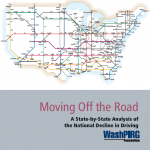Moving Off the Road
A State-by-State Analysis of the National Decline in Driving
Americans have cut their per-person driving miles in 46 states plus Washington, D.C., since the middle of the last decade. The states with the biggest reductions in driving miles generally were not the states hit hardest by the economic downturn. The majority—almost three-quarters—of the states where per-person driving miles declined more quickly than the national average actually saw smaller increases in unemployment compared to the rest of the nation.In Washington state, driving per person in has fallen nearly 9 percent since 1999—it's peak driving year. This is the equivalent of drivers leaving their cars parked for more than a month per year.
Downloads
WASHPIRG Foundation

SEATTLE – Washingtonians have cut their per-person driving miles by 5.5 percent since 2005, while the nation’s long term driving boom appears to have ended, according to a new report from the WashPIRG Education Fund. “Like drivers in almost every state, Washingtonians are driving less,” said Chris Esh, Program Associate for the WashPIRG Education Fund. “It’s time for policy makers to wake up and realize the driving boom is over. We need to reconsider expensive highway expansions and focus on alternatives such as public transit and biking—which people increasingly use to get around.”
The report, “Moving Off the Road: A State-by-State Analysis of the National Decline in Driving,” is based on the most current available government data. Among its findings:
• In Washington, driving per person peaked in 1999—making the state one of the earliest to see a peak in appetites for car travel.
• Since the 1999 driving peak, driving per person in Washington has fallen nearly 9 percent. This is the equivalent of drivers leaving their cars parked for more than a month per year.
• This decline in driving is a national trend. Forty-five other states have reduced per-person driving since the middle of the last decade.
• After World War II, the nation’s driving miles increased steadily almost every year, creating a “driving boom.” Spurred by the growth of the suburbs, low gas prices, and rising auto ownership, the boom lasted 60 years. Now, in stark contrast, the average number of miles driven by Americans is in its eight consecutive year of decline, led by reductions among the younger “Millennial” generation.
• Declines in driving can’t simply be attributed to the recession, since they started well before the economic downturn in 2008. And driving declines don’t correlate closely with unemployment or other indicators of a faltering economy. Other factors—from high gas prices to cultural shifts—are contributing to the shrinking appetite for car travel.
• Washington falls well behind the pace Oregon has set in decreasing driving miles. Since 2005, Oregon has seen an 11.1% drop in driving miles per person—more than doubling the rate at which Washington’s driving mileage rate fell over that period.
According to new federal government data released Monday, driving has continued to decline over the first half of 2013. This is the eighth year in a row in which per-person driving miles have declined for the nation as a whole.
The report is based on data that is published each year by the Federal Highway Administration but that is scattered across numerous publications. Today’s study is the first major public analysis that assembles this data and uses it to compare state-by-state driving trends.
“With driving on the downturn, we need to press the reset button on our transportation policy,” said Esh. “For decades, our state’s transportation investments overwhelmingly went to highway construction. But recent trends show that highway expansions are the wrong choice for Washington’s future.”
Download the report, “Moving Off the Road: A State-by-State Analysis on the National Decline in Driving.”
Download this infographic we created to illustrate the end of the Driving Boom.
# # #
WASHPIRG Education Fund works to protect consumers and promote good government. We investigate problems, craft solutions, educate the public, and offer meaningful opportunities for civic participation.